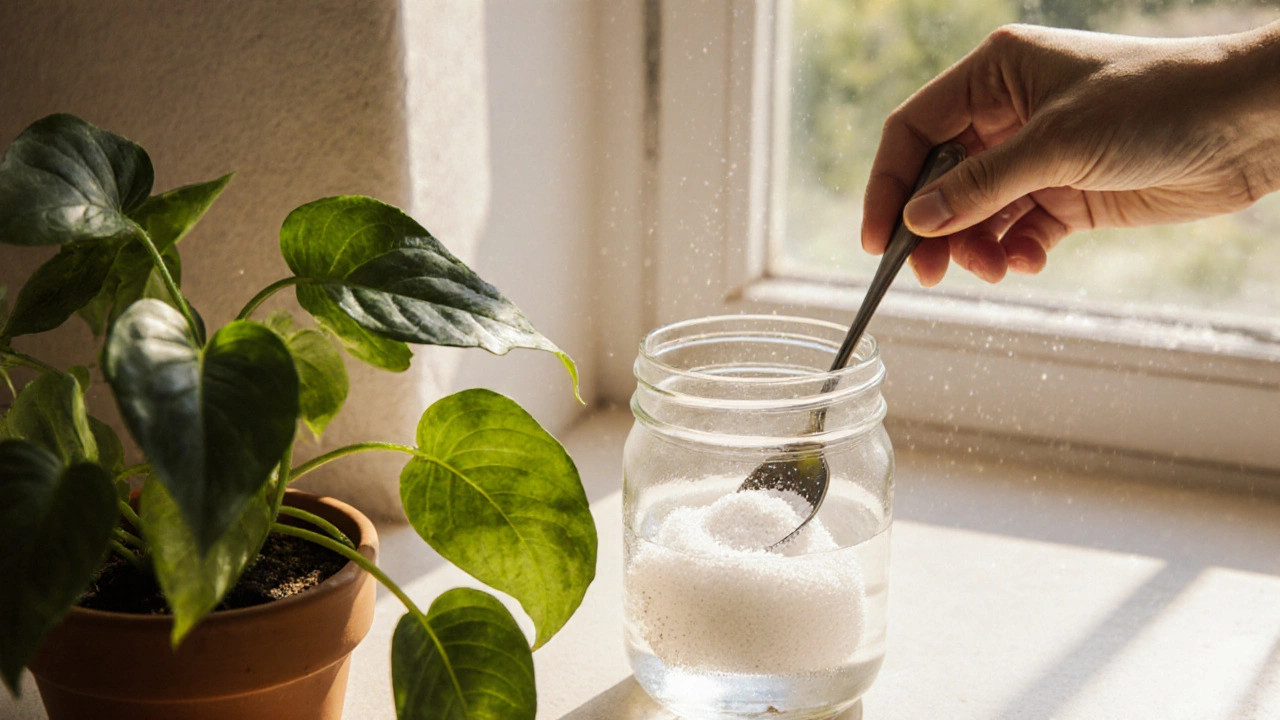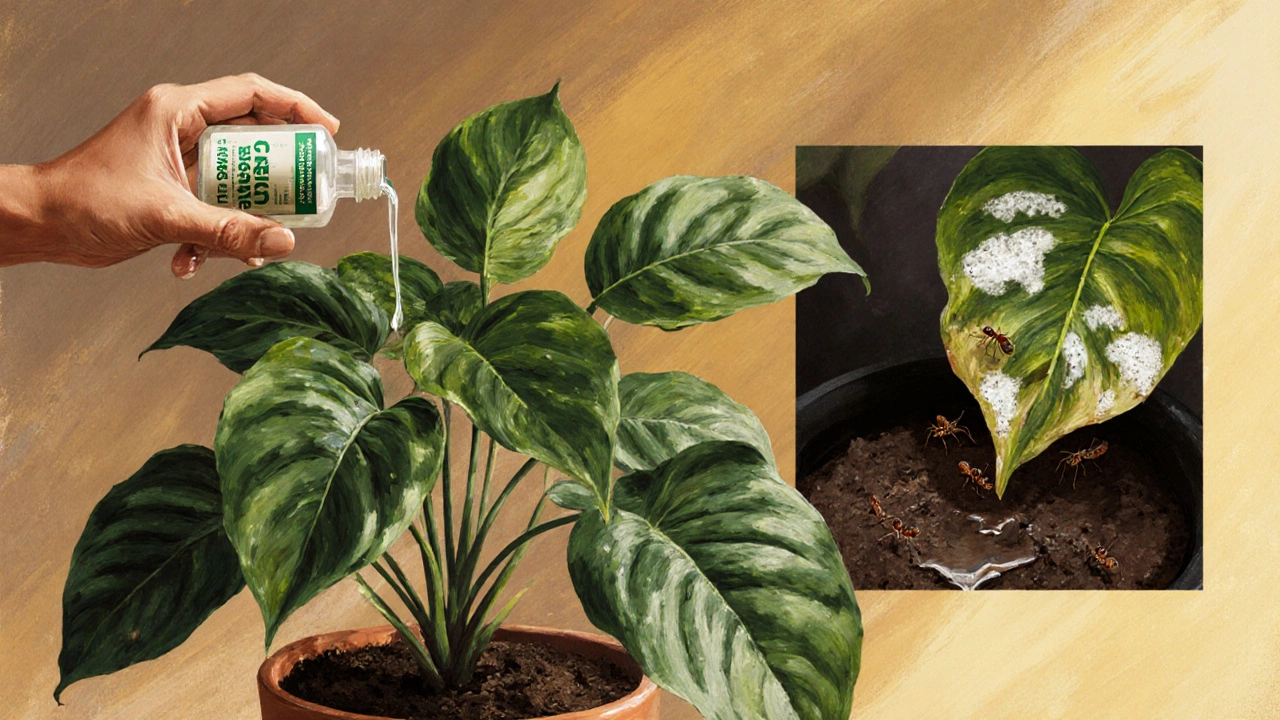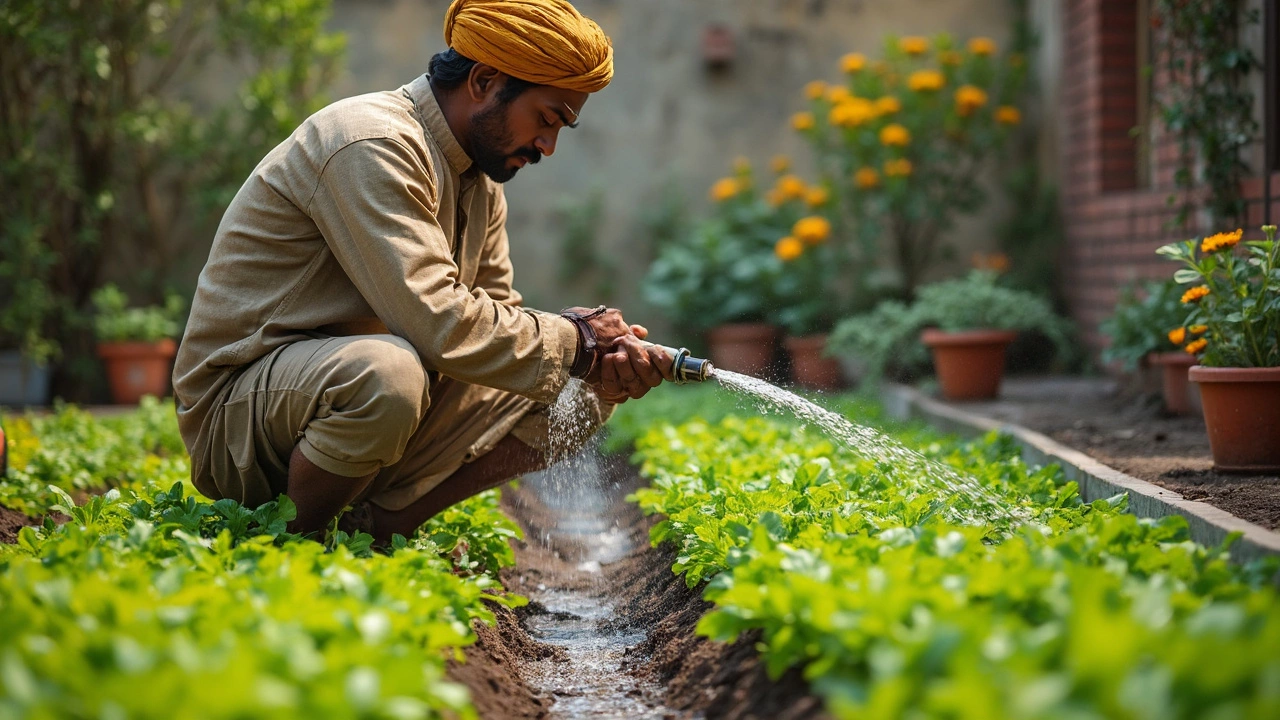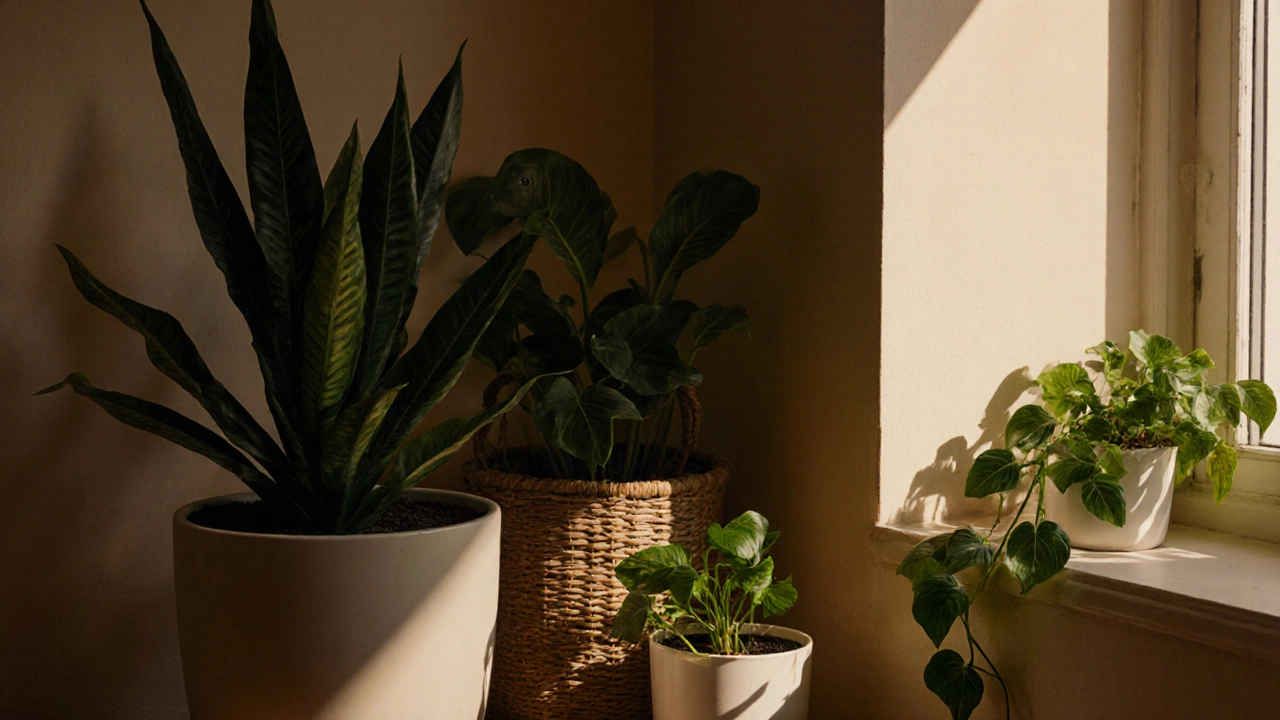Sugar Water for Indoor Plants: Benefits, Risks & How to Use It

Sugar Water Dilution Calculator
How to Use
Recommended: Use a very dilute solution (1 teaspoon sugar per liter of water) only on cuttings or severely stressed houseplants.
Enter water volume and application type to see the recommended sugar amount
Quick Summary
- Pure sugar water can give a short‑term energy boost, but it’s not a substitute for balanced nutrients.
- Over‑doing it causes osmotic stress, encourages fungal growth, and can attract pests.
- Use a very dilute solution (1teaspoon sugar per litre of water) only on cuttings or severely stressed houseplants.
- Regular watering with mineral‑rich fertilizer remains the safest way to keep indoor foliage thriving.
- Monitor leaf colour and soil moisture; any yellowing or soggy soil means you need to stop the sugar feed.
When you hear the phrase sugar water a simple solution of dissolved sugar in water that’s sometimes used as a quick plant “energy drink”, you might wonder if it can replace commercial fertilizer for your indoor jungle. The short answer is: it can help in very specific situations, but it’s not a regular feeding method. Below we unpack the science, the pros and cons, and the exact steps to use it without hurting your green friends.
What exactly is sugar water?
sugar water a mixture of sucrose (table sugar) dissolved in water, typically at a ratio of 1% to 5% is essentially a carbon source without any of the macro‑nutrients (nitrogen, phosphorus, potassium) that plants need for long‑term growth. In the garden hobby world it’s often marketed as a “quick‑fix” for droopy leaves or as a boost for newly taken cuttings.
How plants normally get their food
Every indoor plant a cultivated plant kept inside homes or offices, usually in pots or containers relies on two basic processes: photosynthesis the conversion of light, carbon dioxide and water into glucose and oxygen, and root absorption the uptake of water and dissolved minerals from the growing medium. Photosynthesis creates the plant’s own sugar (glucose) using sunlight, while the roots fetch nitrogen, phosphorus, potassium, calcium, magnesium and trace elements from the soil or growing media.
Potential upside of adding extra sugar
Supplying external sugar can, in theory, give a plant a temporary energy reserve. This is useful in three niche scenarios:
- Rooting cuttings: When you take a leaf or stem cutting, the new tissue has no leaves yet, so it can’t photosynthesize. A mild sugar solution can provide the carbon needed to jump‑start cellular growth.
- Severe stress recovery: Plants that have been under prolonged low light, temperature shock, or drought may benefit from a short‑term boost while they rebuild chlorophyll.
- Hydroponic seed germination: Some growers add a pinch of sugar to the germination medium to speed up the first leaf emergence.
In each case the benefit is brief; once the plant regains its own photosynthetic capacity, the extra sugar becomes unnecessary.

What the research says
A 2022 study in the Journal of Plant Nutrition tested three groups of basil seedlings: plain water, 1% sugar water, and a standard liquid fertilizer. After two weeks, the fertilizer group showed a 28% higher leaf mass, while the sugar water group only saw a 9% increase compared to the control. Importantly, the sugar‑treated seedlings also exhibited more fungal spores on the leaf surface.
Another experiment with spider‑plant cuttings ( Chlorophytum comosum a common houseplant known for its arching green leaves and easy propagation) found that a 0.5% sucrose solution doubled the rooting percentage after ten days, but only when the cuttings were kept in a mist chamber with high humidity.
These findings reinforce a pattern: sugar can help when a plant lacks its own carbon source, but it never replaces the complex mineral nutrition that full‑spectrum fertilizer provides.
Risks and downsides you need to watch
Adding sugar to the potting mix creates a sugary environment that microbes love. The most common problems are:
- Osmotic stress: High sugar concentrations pull water out of plant cells, wilting them faster than normal.
- Fungal overgrowth: Yeasts and molds can proliferate on the soil surface, leading to root rot or leaf spot.
- Pest attraction: Ants, fruit flies, and even aphids are drawn to the sweet residue.
- Nutrient imbalance: Sugar dilutes the concentration of essential minerals, causing deficiencies over time.
Because indoor pots usually have limited drainage, any excess sugar tends to linger, magnifying the problems. That’s why many experienced growers advise against regular sugar feeds.
When (and if) you should use sugar water
Here’s a quick decision tree for the average indoor‑plant hobbyist:
- Are you trying to root a cutting? → Yes: use a dilute sugar solution (<1%); No: skip.
- Is the plant showing signs of severe stress (yellowing, limp leaves) and you can’t fertilize immediately? → Yes: a single mild feed may help; No: stick to regular watering.
- Do you grow hydroponically and need a short germination boost? → Yes: add a pinch of sugar to the seed‑soak; No: avoid.
If none of the above apply, stick with balanced fertilizer and good watering habits.

How to make and apply a safe sugar solution
Follow these steps to keep the risk low:
- Measure 1teaspoon (about 5g) of white granulated sucrose.
- Mix it into 1litre of room‑temperature water. Stir until completely dissolved.
- If you’re treating a cutting, dip the cutting’s base into the solution for 30seconds, then plant it in a well‑draining medium.
- For a stressed houseplant, water the pot with just enough solution to wet the top inch of soil, then let it drain fully.
- Do not repeat the feed more than once every two weeks, and never exceed the 1% concentration.
After application, monitor the soil moisture with a finger test. If the soil feels sticky or smells sweet, flush it with plain water to rinse out excess sugar.
Better alternatives for everyday feeding
Instead of sugar, consider these proven options:
- Balanced liquid fertilizer: Provides nitrogen, phosphorus, potassium, and micronutrients in ratios plants need.
- Compost tea: A watery extract of decomposed organic matter that adds microbes and nutrients without the sugar spike.
- Organic humic acids: Improve root uptake and soil structure, especially in low‑fertility potting mixes.
These alternatives nourish the plant over weeks rather than a single burst, and they keep the microbial community in check.
| Treatment | Nutrient content | Effect on growth | Main risk |
|---|---|---|---|
| Sugar water (1%) | Carbon only (no N‑P‑K) | Short‑term vigor boost on cuttings | Fungal growth, osmotic stress |
| Plain water | None | Maintains hydration, no growth impact | None |
| Balanced liquid fertilizer | Full N‑P‑K + micronutrients | Steady leaf and root development | Over‑fertilization if mis‑dosed |
Key take‑away checklist
- Use sugar water only for cuttings or brief stress recovery.
- Keep the solution ≤1% and apply no more than once every two weeks.
- Watch for sticky soil, mold, or pest activity - stop immediately if they appear.
- Maintain a regular fertilization schedule for long‑term health.
- Flush any excess sugar out of the pot with plain water.
Frequently Asked Questions
Can I use brown sugar instead of white sugar?
Yes, but brown sugar contains molasses, which adds extra minerals that can further promote microbial growth. If you choose brown sugar, stick to an even lower concentration (½% max) and monitor the soil closely.
Will sugar water help revive a plant that’s been over‑watered?
No. Over‑watering already stresses the root system by limiting oxygen. Adding sugar can worsen the situation by feeding pathogens. The best cure is to let the soil dry out and improve drainage.
How often can I feed my pothos with sugar water?
Only once a month, and only if the plant is a cutting or has been under extreme low light for weeks. Regular watering with a balanced fertilizer is far more effective for a mature pothos.
Is there any benefit to adding a pinch of sugar to hydroponic nutrient solutions?
A tiny amount (≈0.1%) can help seedling germination, but most commercial hydroponic mixes already contain carbohydrate precursors. Adding more sugar can cause algae blooms and clog pumps.
What signs show that a plant is reacting negatively to sugar water?
Look for yellowing or browning leaf edges, a sticky feel on the soil surface, white fungal patches, or an increase in ants and flies around the pot. Any of these cues mean you should flush the soil and stop sugar feeds.





